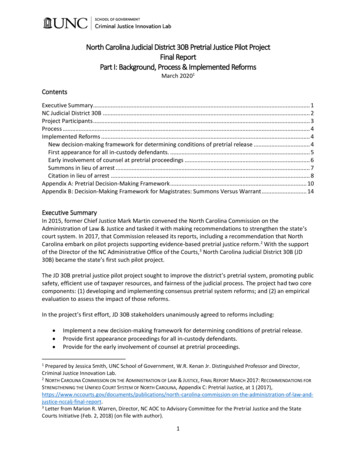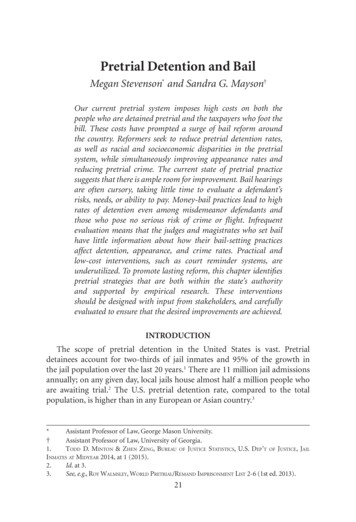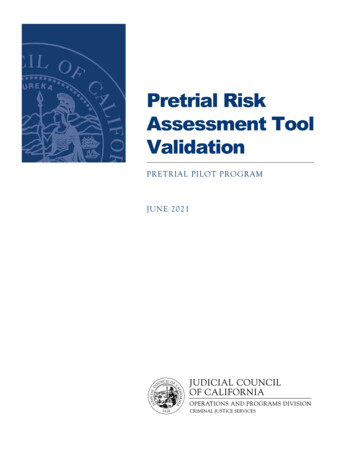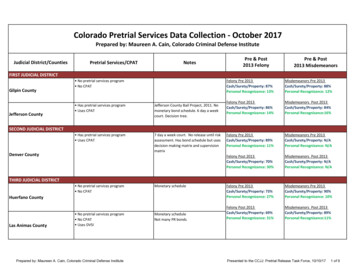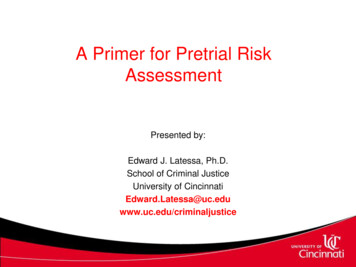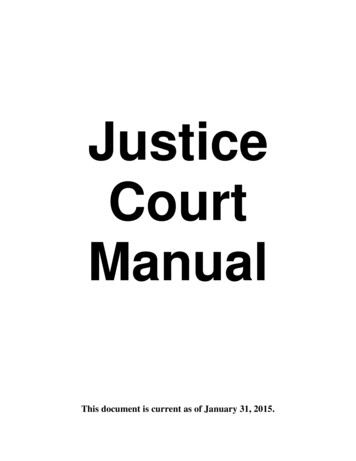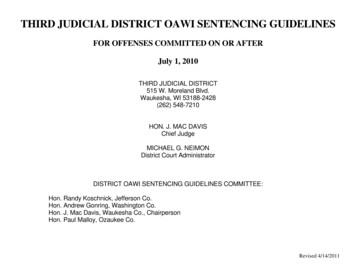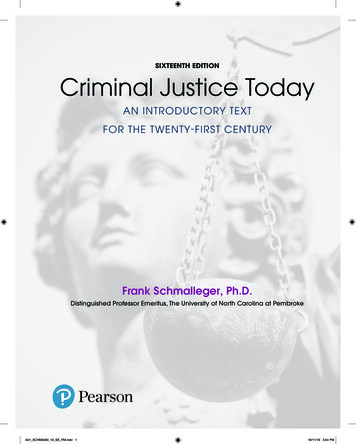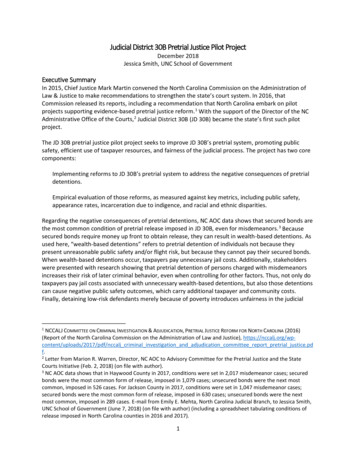
Transcription
Judicial District 30B Pretrial Justice Pilot ProjectDecember 2018Jessica Smith, UNC School of GovernmentExecutive SummaryIn 2015, Chief Justice Mark Martin convened the North Carolina Commission on the Administration ofLaw & Justice to make recommendations to strengthen the state’s court system. In 2016, thatCommission released its reports, including a recommendation that North Carolina embark on pilotprojects supporting evidence-based pretrial justice reform. 1 With the support of the Director of the NCAdministrative Office of the Courts, 2 Judicial District 30B (JD 30B) became the state’s first such pilotproject.The JD 30B pretrial justice pilot project seeks to improve JD 30B’s pretrial system, promoting publicsafety, efficient use of taxpayer resources, and fairness of the judicial process. The project has two corecomponents:Implementing reforms to JD 30B’s pretrial system to address the negative consequences of pretrialdetentions.Empirical evaluation of those reforms, as measured against key metrics, including public safety,appearance rates, incarceration due to indigence, and racial and ethnic disparities.Regarding the negative consequences of pretrial detentions, NC AOC data shows that secured bonds arethe most common condition of pretrial release imposed in JD 30B, even for misdemeanors. 3 Becausesecured bonds require money up front to obtain release, they can result in wealth-based detentions. Asused here, “wealth-based detentions” refers to pretrial detention of individuals not because theypresent unreasonable public safety and/or flight risk, but because they cannot pay their secured bonds.When wealth-based detentions occur, taxpayers pay unnecessary jail costs. Additionally, stakeholderswere presented with research showing that pretrial detention of persons charged with misdemeanorsincreases their risk of later criminal behavior, even when controlling for other factors. Thus, not only dotaxpayers pay jail costs associated with unnecessary wealth-based detentions, but also those detentionscan cause negative public safety outcomes, which carry additional taxpayer and community costs.Finally, detaining low-risk defendants merely because of poverty introduces unfairness in the judicialNCCALJ COMMITTEE ON CRIMINAL INVESTIGATION & ADJUDICATION, PRETRIAL JUSTICE REFORM FOR NORTH CAROLINA (2016)(Report of the North Carolina Commission on the Administration of Law and Justice), lj criminal investigation and adjudication committee report pretrial justice.pdf.2Letter from Marion R. Warren, Director, NC AOC to Advisory Committee for the Pretrial Justice and the StateCourts Initiative (Feb. 2, 2018) (on file with author).3NC AOC data shows that in Haywood County in 2017, conditions were set in 2,017 misdemeanor cases; securedbonds were the most common form of release, imposed in 1,079 cases; unsecured bonds were the next mostcommon, imposed in 526 cases. For Jackson County in 2017, conditions were set in 1,047 misdemeanor cases;secured bonds were the most common form of release, imposed in 630 cases; unsecured bonds were the nextmost common, imposed in 289 cases. E-mail from Emily E. Mehta, North Carolina Judicial Branch, to Jessica Smith,UNC School of Government (June 7, 2018) (on file with author) (including a spreadsheet tabulating conditions ofrelease imposed in North Carolina counties in 2016 and 2017).11
process. 4 Compounding the unfairness of wealth-based detentions, stakeholders were presented withresearch showing that, controlling for other factors, low-level defendants who are detained pretrial aremore likely to experience negative case outcomes (such as conviction, custodial sentence, and longersentence) than similarly situated defendants who are released pretrial. 5 These and other reasonssuggested that better “front end” pretrial processes and decisions will promote fairness, public safetyand efficient use of taxpayer funds.To improve pretrial decision-making JD 30B stakeholders unanimously agreed to six reforms: Implement a new decision-making framework for determining conditions of pretrial release.Provide a timely first appearance for all in-custody defendants.Provide for the early involvement of counsel at pretrial proceedings.Promote the increased use of citations in lieu of arrest.Promote the increased use of summons in lieu of arrest.Provide detention bond hearings for persons intentionally detained on secured bonds.Reforms take effect January 1, 2019. With regard to the project’s second core component, empiricalevaluation will examine the effectiveness of these reforms.Why JD 30B?JD 30B consists of Haywood and Jackson counties. Several characteristics of JD 30B make it an importantpilot program site. First, JD 30B serves a distinct minority population, the Eastern Band of CherokeeIndians. 6 Ensuring that pretrial practices operate in a race-neutral manner is an important component ofevidence-based pretrial practices. 7 Second, because JD 30B is a rural community, results of the pilotproject will add important information to the growing body of research on effective pretrial releasepractices, which to date has focused largely on urban and suburban communities. 8 Third, JD 30B--likemany rural jurisdictions--lacks resources that are often available in urban and suburban jurisdictions;specifically, JD 30B has no county-funded pretrial services and is not served by a public defender office.The unfairness inherent in North Carolina’s money-based bail system has long been noted. Almost 50 years ago—well before federal and state cases held that money-based bail systems violated equal protection, see, e.g., JessicaSmith, Fifth Circuit: Bail System Violated Due Process & Equal Protection, NC CRIMINAL LAW BLOG (Mar. 26, ion/ —a law reviewcomment entitled Bail in North Carolina asserted:Since release on bail is usually dependent upon payment of money to a bondsman, the systemtends to discriminate against the poor who cannot afford such payment. If a rich man and a poorman are both innocent and both accused of the same crime, only the rich man can generallyobtain his release on bail. The poor man, even though later acquitted, must suffer thehumiliation of a period in jail and any possible number of attendant consequences, such as theloss of his job or the disruption of his family life.Richard B. Howington, Comment, Bail in North Carolina, 5 WAKE FOREST INTRAMURAL L. REV. 300, 303 (1969). Researchnow shows that the consequences of pretrial detention are more significant than humiliation, job loss, anddisruption of family life. See infra note 5 and accompanying text.5See, e.g., Paul Heaton et al., The Downstream Consequences of Misdemeanor Pretrial Detention, 69 STAN. L. REV.711 (2017), etention/.6Letter from Marion R. Warren, Director, NC AOC supra note 2.7Id.8Id.42
Effective implementation of evidence-based pretrial reform in such a district may provide importantlessons for how communities, notwithstanding limited resources, can improve their pretrial systems.ParticipantsThis pilot project was initiated and led by Senior Resident Superior Court Judge Bradley B. Letts. Otherjudicial system participants included District Court Judges; Magistrates; Clerks of Court; the DistrictAttorney and Assistant District Attorneys in that office; defense lawyers; and members of the lawenforcement community, broadly defined to include sheriff and police departments, campus police, andjail administrators. In addition to these local stakeholders, this project was supported by: Professor Jessica Smith, W.R. Kenan, Jr. Distinguished Professor, School of Government, TheUniversity of North Carolina at Chapel Hill. Professor Smith supported the project by helping tosecure project funding; leading and facilitating stakeholder meetings and engagement; providinglegal advice and analysis; developing and writing Implementation Plans for each of the reforms;coordinating data collection from the NC AOC; and writing reports. Funding from Smith’sendowed professorship covered her travel to and from JD 30B, meals for meeting participants,printing of the Cite or Arrest pocket card for officers and the new pretrial release decisionmaking rubric.Professor Jamie Vaske, Associate Professor, Western Carolina University. Professor Vaske leadsthe project’s evaluation component, including designing evaluation plans; securing funding forevaluations; obtaining Institutional Review Board approval; supervising student support; andworking with stakeholders to develop systems to collect key data points. In January 2019, Vaskewill begin executing project evaluation, and is responsible for all evaluation reports.Tom Maher, Executive Director, NC Indigent Defense Services (NC IDS) and NC IDS. Maherplayed a key role in implementation of the early involvement of counsel reform; NC IDS issupporting the project by paying contract lawyers’ fees and administering the early involvementof counsel program.NC AOC Research and Planning. Staff in the NC AOC office of Research and Planning providedassistance with respect to collecting and understanding NC AOC data.State Justice Institute (SJI). This project was supported by a grant from the SJI, administered bythe National Center for State Courts and the Pretrial Justice Institute (PJI). Grant fundingsupported technical assistance by PJI. Specifically, PJI’s Will Cash and John Clark led the project’skick-off meetings. Clark served as a project consultant and led training for stakeholders on newpretrial procedures.ProcessThe project began with two public “kick off” meetings in June 2018—one in Haywood County; one inJackson County. At those meetings Cash and Clark presented on, among other things, problems with thecurrent pretrial release systems; the negative consequences of pretrial detention—both for defendantsand society; legal and evidence-based pretrial practices; pretrial reform efforts underway around thecountry; the results of such reforms and support for them from a wide variety of groups, including theConference of Chief Justices, the National Sheriffs Association, the Association of Prosecuting Attorneys,and a broad range of advocacy groups; and growing pressure for reform caused by successful legalchallenges to existing bail systems. PJI staff also facilitated a discussion in which stakeholders prioritizedreforms they wished to implement in JD 30B.3
After the June meeting, Professor Smith prepared draft Implementation Plans for the reforms identifiedby stakeholders as viable options and priorities. In August 2018, Smith facilitated a public meeting withstakeholders to refine those plans. She then incorporated stakeholder feedback and produced revisedImplementation Plans. She facilitated a public meeting in September 2018 for stakeholders to reviewthe revised plans; this included testing the new pretrial decision-making framework through a series ofcase scenarios. Between all meetings, Smith communicated with stakeholders, getting additionalfeedback on plan details, addressing areas of concern, and preparing revised Implementation Plansincorporating this feedback. On a parallel track, Professor Vaske attended meetings and designed anddeveloped evaluation plans for all identified reforms, including obtaining approvals and permissionsfrom NC AOC, IRB, and others. A final meeting was held in December 2018, primarily to provide trainingon all of the adopted reforms, but also for final refinement of the Implementation Plans and tools. Afterthat meeting Smith finalized and arranged for printing and delivery of necessary materials, worked withClark to develop a training guide on the new Cite or Arrest pocket card for officers, and Judge Lettsissued a revised Local Bail Policy and necessary Standing Orders.Implemented ReformsNew decision-making framework for determining conditions of pretrial releaseJD 30B’s current Local Bail Policy includes a table setting suggested bond amounts based on thepunishment class of the charged offense. Best practices recommend against the use of such tables. 9Additionally, stakeholders determined that although the current charge’s offense class is relevant to thebail decision, other individualized factors regarding the defendant and the circumstances of the offenseare important in assessing appropriate conditions of pretrial release. Moreover they found that thecurrent Bail Policy and its bond tables tend to push decision-makers towards a secured bond incontravention of state law, which requires release on a written promise, custody release, or unsecuredbond unless the decision-maker finds that those conditions will not reasonably assure appearance; willpose a danger of injury to any person; or are likely to result in the destruction of evidence, subornationof perjury, or intimidation of witnesses. 10 And finally, stakeholders wanted to develop an easilyimplemented tool that would quickly identify those defendants who can be released on non-financialconditions, 11 to reduce the occurrence of wealth-based incarceration of individuals who pose little riskto public safety or of flight. Although they considered available empirical risk assessment tools for thatpurpose, they did not opt for such a tool, in part because they lacked the resources necessary to gatherthe input information required by these tools. Instead, they opted to create a screening device based oneasily determined defendant- and offense-specific factors.The JD 30B project includes a new decision-making framework for determining conditions of pretrialrelease, included in Appendix A. The new framework applies in all circumstances except where thestatutes require other considerations or outcomes. Key features include:ABA STANDARDS FOR CRIMINAL JUSTICE: PRETRIAL RELEASE, Standard 10-5.3(e) (3d ed. 2007) ("Financial conditions shouldbe the result of an individualized decision taking into account the special circumstances of each defendant, thedefendant's ability to meet the financial conditions and the defendant's flight risk, and should never be set byreference to a predetermined schedule of amounts fixed according to the nature of the aba/publications/criminal justice standards/pretrial release.authcheckdam.pdf.10G.S. 15A-534(b).11Because a written promise, custody release, and unsecured bond require no money up front to secure release,this report refers to those conditions as “non-financial conditions.”94
An easily implemented, stakeholder-created tool to quickly identify low-risk defendants whoimmediately can be released on non-financial conditions. 12A requirement that decision-makers follow the statutory mandate and impose non-financialconditions unless they determine that such release will not reasonably assure appearance; willpose a danger of injury to any person; or is likely to result in the destruction of evidence,subornation of perjury, or intimidation of witnesses. 13Detailed notes guiding decision-makers through the decision-making process. 14Recommended maximum bond amounts for secured bonds 15 and the requirement that ability topay be considered in connection with imposition of that form of release. 16Requiring documentation of reasons for imposing a secured bond 17 and deviating fromrecommendations in the framework. 18First appearance for all in-custody defendants.This reform provides first appearances for in-custody defendants charged with misdemeanors and ClassH and I felonies (highest charge) or arrested on a probation violation within 72 hours of arrest or at thefirst regular session of the district court in the county, whichever occurs first.Current law requires a first appearance for in-custody felony defendants within 96 hours of being takeninto custody or at the first regular session of the district court in the county, whichever occurs first. 19Because the law does not require first appearances for in-custody misdemeanor defendants, thesedefendants may sit in jail for weeks or more until their first court date. This can lead to scenarios wheremisdemeanor defendants are incarcerated pretrial when the charged offense cannot result in acustodial sentence upon conviction or where they are incarcerated pretrial for a longer period than theycould receive in a custodial sentence if convicted. Additionally, stakeholders learned of researchsuggesting that pretrial detention of low-level defendants has negative public safety consequences andnegative case outcomes for defendants. These reasons counsel in favor of first appearances for incustody misdemeanor defendants, to ensure prompt judicial review of the magistrate’s bonddetermination and a determination that detention is warranted because of pretrial risk as opposed toinability to pay financial conditions. Additionally, a separate reform in JD 30B (discussed below) providesfor NC IDS contract counsel for in-custody defendants charged with misdemeanors and Class H and Ifelonies as well as those arrested on probation violations; the new first appearances are necessary toeffectuate that reform.The screening tool appears as the large box in the middle of page 2 of the new decision-making framework fordetermining conditions of pretrial release, included in Appendix A.13The requirement that judicial officials apply the statutory mandate is expressly reflected in the new decisionmaking framework for determining conditions of pretrial release, included in Appendix A. Specifically, see thesecond box in the middle of page 2.14See page 3 of the new decision-making framework for determining conditions of pretrial release, included inAppendix A.15See n.15 on page 3 and the associated tables on page 4 of the new decision-making framework for determiningconditions of pretrial release, included in Appendix A.16See n.15 on page 3 of the new decision-making framework for determining conditions of pretrial release,included in Appendix A.17G.S. 15A-535(a) (local pretrial release policy may include a requirement that each judicial official who imposes asecured bond record the reasons for doing so in writing).18See page 2 of the new decision-making framework for determining conditions of pretrial release, included inAppendix A. Specifically, see the green and red boxes on that page.19G.S. 15A-601(c).125
To promote judicial efficiency, the new first appearances will be held at 2 pm in district court. Holdingthese proceedings in the afternoon affords new contract counsel (see below) time to meet with clientsat the jail and to obtain and review defendants’ criminal history record.Early involvement of counsel at pretrial proceedingsEarly involvement of counsel at pretrial proceedings will better inform judges’ pretrial decisions andprotect defendants’ rights in light of the significant consequences associated with pretrial detention. 20Early involvement of counsel is recommended by national standards 21 and has been specificallyrecommended for North Carolina. 22This reform includes a Standing Order issued by the Senior Resident Superior Court Judge providing forthe appointment of NC IDS retained “contract counsel” to represent defendants at the first appearanceand the first detention bond hearing (if any; see below). Covered defendants include those whosehighest charge is a misdemeanor or Class H or I felony and those arrested for a probation violation.Contract counsel will meet with defendants at the jail and review defendants’ criminal history recordsprior to the first appearance. Contract counsel will be retained and paid pursuant to contracts with NCIDS. Contract counsel will serve only for these purposes; assigned counsel will be appointed to representdefendants after the first appearance and first detention bond hearing (if any).To implement this reform, NC IDS has agreed to: Hire, contract, and supervise contract counsel.Set payment rates for contract counsel and approve all payments to contract counsel.Establish procedures for handling defendants who are arrested on an Order for Arrest for aFailure to Appear and already have assigned counsel.Develop contracts specifying performance expectations, including: meeting with the client at thejail before the first appearance; reviewing the client’s criminal history; preparing an intake formfor each defendant; and advocating for the client at the first appearance and the first detentionbond hearing (if any).Establish a plan to train contract counsel on pretrial advocacy, as feasible.Establish procedures for dealing with conflicts.Develop forms and other job tools for contract counsel, such as an intake form to be used duringthe client interview.Local jail supervisors have agreed to provide timely jail lists to contract counsel and to set aside a privatemeeting place for counsel to meet with jailed defendants prior to the first appearance.See, e.g., Paul Heaton et al., supra note 5.ABA STANDARDS FOR CRIMINAL JUSTICE: PROSECUTION AND DEFENSE FUNCTION, Defense Function Standard 4-2.3 (4th ed.2015) ("A defense counsel should be made available in person to a criminally-accused person for consultation at orbefore any appearance before a judicial officer, including the first riminal NORTH CAROLINA COMMISSION ON THE ADMINISTRATION OF LAW & JUSTICE, FINAL REPORT MARCH 2017: RECOMMENDATIONS FORSTRENGTHENING THE UNIFIED COURT SYSTEM OF NORTH CAROLINA, Appendix D: Improving Indigent Defense Services, at 30(2017), alj final report.pdf.20216
In order to meaningfully represent a defendant at first appearances and to ensure procedural fairness,contract counsel needs the defendant’s criminal history record, which is used by the ADA and judge atthat proceeding. The District Attorney’s Office has agreed to run these records for each defendant onthe 72-Hour Jail Calendar before the noon lunch hour; contract counsel will go to the District Attorney’sOffice to review the records in advance of the new first appearances, which—as noted above—will beheld at 2 pm to afford sufficient time for these tasks.Interpreter services will be provided, as needed, to contract counsel through the NC AOC telephonicinterpreter services. Jail administrators have agreed to allow telephones in client meeting spaces for thispurpose.Increased use of citations in lieu of arrestThis reform includes implementation of a law enforcement driven and approved tool for patrol officersto encourage the increased use of citations in lieu of arrest for certain misdemeanors, in the officer’sdiscretion. Specifically, a Cite or Arrest Pocket Card, shown in Figure 1 below. Although the overallproject was a collaborative, multi-stakeholder endeavor, only the law enforcement communityparticipated in the creation of the Pocket Card.Figure 1: Cite or Arrest Pocket Card7
Promoting the increased use of citation in lieu of arrest is recommended by law enforcement and othergroups. 23 Use of citations is widely embraced as a law enforcement tool, 24 and promoting the greateruse of citations has been adopted as a criminal justice strategy elsewhere. 25 Greater use of citationsoffers potential benefits, including increased efficiency for law enforcement. One report found thatcitations require 24.2 minutes to process versus arrests, which require 85.8 minutes; citations thus offera time savings of just over an hour per incident. 26 Promoting the increased use of citations in lieu ofarrests also can help reduce unnecessary pretrial detentions of low-risk defendants and associatedcosts, unfairness, and negative public safety outcomes. An arrest triggers an initial appearance andimposition of conditions of pretrial release. Because secured bonds are the most common conditionimposed in JD 30B, the decision to make an arrest versus issue a citation often results in imposition of asecured bond and associated wealth-based detentions described above. Thus, it is asserted that betterdecisions regarding whether to issue a citation versus making an arrest will promote officer efficiency,public safety, and efficient use of taxpayer funds. 27Local law enforcement agencies will distribute the pocket card to officers and provide training on use ofthe card at Roll Call. To facilitate training, a training guide, provided in Appendix B, was distributed tolocal agencies.Increased use of summons in lieu of arrestRelated to the new decision-making framework for pretrial release decisions, this reform seeks topromote the increased use of summons in lieu of arrest for cases where a defendant would be releasedon non-financial conditions and does not require pretrial restrictions.This change is designed to implement best practices, 28 give effect to the statutory direction that awarrant for arrest should issue when a person needs to be taken into custody, 29 statutory rulesregarding citizen’s warrants, 30 and to reduce wealth-based pretrial detentions of low-risk defendants. Anarrest triggers an initial appearance and imposition of conditions of pretrial release. Because securedSee, e.g., FINAL REPORT OF THE PRESIDENT’S TASK FORCE ON 21ST CENTURY POLICING 43 (2015), rces/170926/FinalReport21stCenturyPolicing.pdf; ABA STANDARDS FOR CRIMINALJUSTICE: PRETRIAL RELEASE, Standard 10-1.3 (3d ed. publications/criminal justice standards/pretrial release.authcheckdam.pdf.24INTERNATIONAL ASSOCIATION OF CHIEFS OF POLICE, CITATION IN LIEU OF ARREST: EXAMINING LAW ENFORCEMENT’S USE OF CITATIONACROSS THE UNITED STATES (2016), , e.g., CHARLESTON COUNTY CRIMINAL JUSTICE COORDINATING COUNCIL (South Carolina), ANNUAL REPORT 2017(discussing increased use of “cite and release” practices in that les/2017annualreport.pdf.26INTERNATIONAL ASSOCIATION OF CHIEFS OF POLICE, supra note 24, at 3.27National Conference of State Legislatures, Citation in Lieu of Arrest (Nov. 1, 2017) (“States may use citations toreduce jail populations and provide local cost savings. Citations divert lower risk offenders from detention,reserving limited space and resources for more dangerous offenders. By providing an alternative to pretrialdetention and release processes for certain defendants, citation in lieu of arrest can be considered a component ofstate pretrial policies.”), stice/citation-in-lieu-of-arrest.aspx.28ABA STANDARDS FOR CRIMINAL JUSTICE: PRETRIAL RELEASE, Standard 10-1.3 (3d ed. publications/criminal justice standards/pretrial release.authcheckdam.pdf.29G.S. 15A-304(b)(1).30G.S. 15A-304(b)(3).238
bonds are the most common condition imposed in JD 30B, the decision to issue a warrant for arrest overa summons often results in imposition of a secured bond. As noted above, imposition of secured bondscan lead to unnecessary detentions and associated costs, both to taxpayers, the community in terms ofnegative public safety results, and for the defendants.This reform will be effectuated by incorporating into the Local Bail Policy a new decision-makingframework for magistrates when deciding whether to issue a summons versus a warrant. The newdecision-making framework is provided in Appendix C.Detention bond hearings for defendants intentionally detained on secured bondsFor those defendants intentionally detained on unattainably high secured bonds because of concernsabout public safety, flight risk, and risk of subornation of perjury, destruction of evidence, andintimidation of witnesses, the JD 30B Local Bail Policy will be revised to provide for a detention bondhearing. At that hearing, defendants will be provided with the procedural protections understood to bepart of a constitutionally compliant preventative detention scheme, including among other things theright to counsel; the right to present evidence; and proof by the State, by clear and convincing evidence,that no condition of release can reasonably assure safety, appearance, and protection of the judicialprocess.EvaluationAs noted, this project includes an empirical evaluation of all implemented reforms. Professor Vaske, willlead that evaluation effort and will provide stakeholders with an interim six-month report and a finalreport after the project has been in effect for 12 months.The evaluation will consist of process and outcome evaluations to assess the fidelity of implementation,as well as the effects of the reforms on appearance rates, public safety, pretrial release, and jail costs.The outcome evaluation will use a quasi-experimental design with a historical control group andpropensity score matching to assess differences in outcomes before and after implementation.9
Appendix A: Pretrial Decision-making Framework10
11
12
13
Appendix B: Cite or Arrest Training GuideTraining Guide--Citation Pocket CardKey Points:1. While law enforcement officers always have discretion when deciding whether to issue acitation in lieu of making an arrest, issuance of a citation for a misdemeanor is recommendedwhen none of the conditions listed on the Pocket Card are present.2. If one or more of following conditions are present, a citation may be issued or an arrest may bemade, in the officer’s discretion.ConditionInterpretationPocket Card conditions that are clearly objective(i.e., either the condition exists or it does not, with little to no room for interpretation)Offense involved physical harm to aExample: Defendant hit a person. Taking or injuring property isp
In 2015, Chief Justice Mark Martin convened the North Carolina Commission on the Administration of Law & Justice to make recommendations to strengthen the state's court system. In 2016, that Commission released its reports, including a recommendation that North Carolina embark on pilot projects supporting evidence-based pretrial justice reform.
